Radxa ROCK 3A is a single board computer powered by Rockchip RK3568 quad-core Cortex-A55 processor that closely follows Raspberry Pi 3 Model B form factor like the early Rock Pi 4 SBC, but with a twist.
By switching from a Rockchip RK3399 to a Rockchip RK3568, the board loses some CPU and GPU performance, but gains extra I/Os with enabled the company to add an additional M.2 slot with PCIe to ROCK 3A board, meaning it’s now possible to attach one NVMe SSD and another M.2 module like a WiFi 6 M.2 card.
ROCK 3A preliminary specifications:
- SoC – Rockchip RK3568 quad-core Cortex A55 processor at up to 2GHz, with Mali G52 GPU, 0.8TOPS NPU
- System Memory – 2GB, 4GB, 8GB LPDDR4 3200MT/s, up to 1560MHz
- Storage
- Pluggable eMMC module
- MicroSD card slot
- M.2 M key socket for NVMe with PCIe 3.0 x2 lanes
- 4MB SPI flash with support for NVMe booting (TBC)
- Video Output
- HDMI 2.0 port up to 4Kp60
- 1x MIPI DSI connector
- Audio – 3.5mm audio jack, digital audio via HDMI
- Camera – 1x MIPI CSI connector
- Connectivity
- Gigabit Ethernet with PoE support
- M.2 E key for connectivity with PCIe 2.0 x1/SDIO/UART, including support for WiFi 6 cards
- USB – 2x USB 2.0 ports, 2x USB3.0 (1x OTG+1x HOST) ports both configurable in SATA mode with a SATA breakout cable
- Expansion – Color-coded 40-pin GPIO header mostly compatible with ROCK Pi 4 and Raspberry Pi 3/4
- Misc – RTC with connector for backup battery
- Power Supply – Via USB-C port with QC/PD power support through a “new generation QC/PD protocol IC”
- Dimensions – 85 x 54 mm
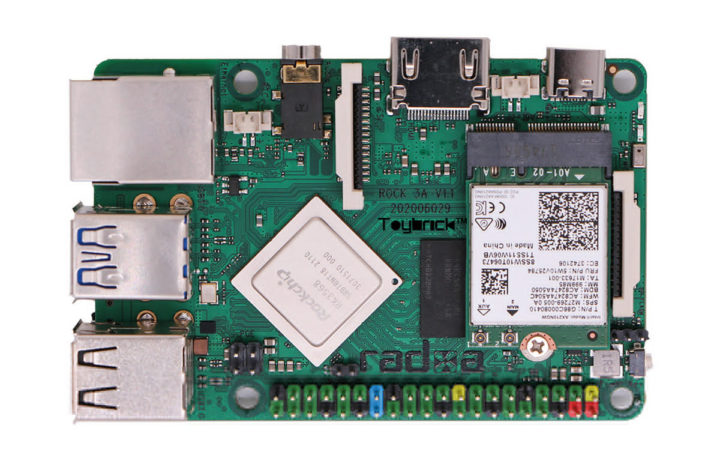
Radxa collaborated with Toybrick to bring Debian 10 support to the board, but third-party operating systems will also be provided with Manjaro Linux, Slackware Arm, etc.. being some candidates.
The storage option for the board can be found on the bottom with the MicroSD card socket, eMMC flash socket, and second M.2 socket on the right side of the board.
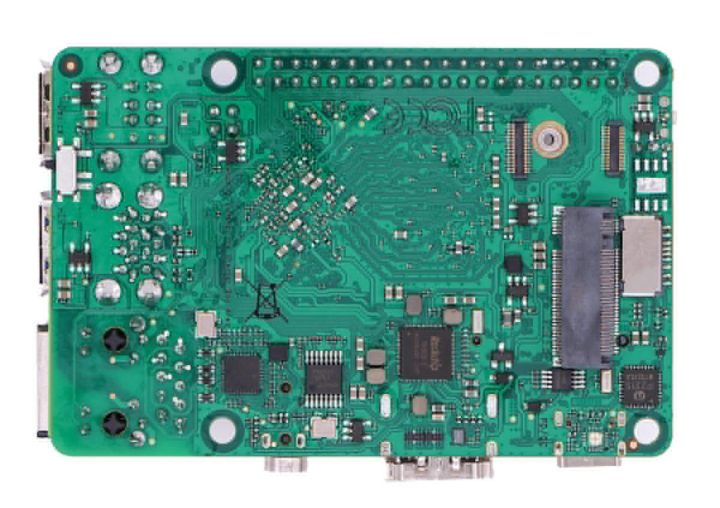 Inquiring minds will notice there’s no mounting screw for the SSD. So how does that work exactly? We can look at a photo for Rock Pi 4 which uses the same setup with an expansion board placed on top of the single board computer.
Inquiring minds will notice there’s no mounting screw for the SSD. So how does that work exactly? We can look at a photo for Rock Pi 4 which uses the same setup with an expansion board placed on top of the single board computer.
Another oddity is SATA support through the USB 3.1 ports. What kind of sorcery it is. We don’t have photos of the SATA expansion just yet, but you can read the second part of our in-depth RK3568 article which explains the processor comes with various multiplexed SERDES lanes two of which can be configured as SATA or USB 3.1 by software as shown in the diagram below.
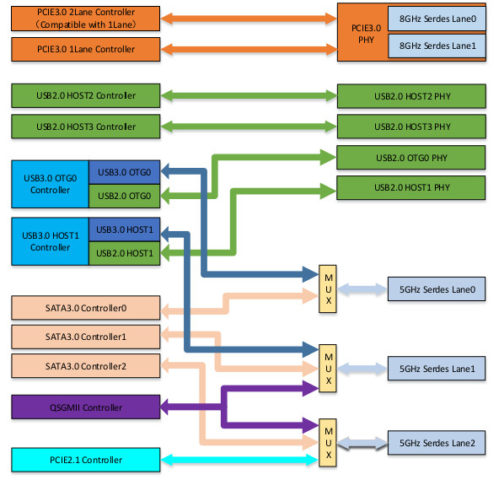
Hopefully, there are safeguards in place on ROCK 3A SBC to avoid hardware damage while connecting a USB device in SATA mode and a SATA drives in USB mode.
ROCK 3A board will match Raspberry Pi 4 pricing with the 2GB RAM version going for $35 US, the 4GB model for $55 US, and finally, the 8GB variant will sell for $75. The single board computer is not available right now with only a few early samples for developers. A larger batch will be manufactured at the end of August, I’d assume still for developers and enthusiasts, and we should probably expect the ROCK 3A to become more broadly available by the end of the year.

Jean-Luc started CNX Software in 2010 as a part-time endeavor, before quitting his job as a software engineering manager, and starting to write daily news, and reviews full time later in 2011.
Support CNX Software! Donate via cryptocurrencies, become a Patron on Patreon, or purchase goods on Amazon or Aliexpress. We also use affiliate links in articles to earn commissions if you make a purchase after clicking on those links.


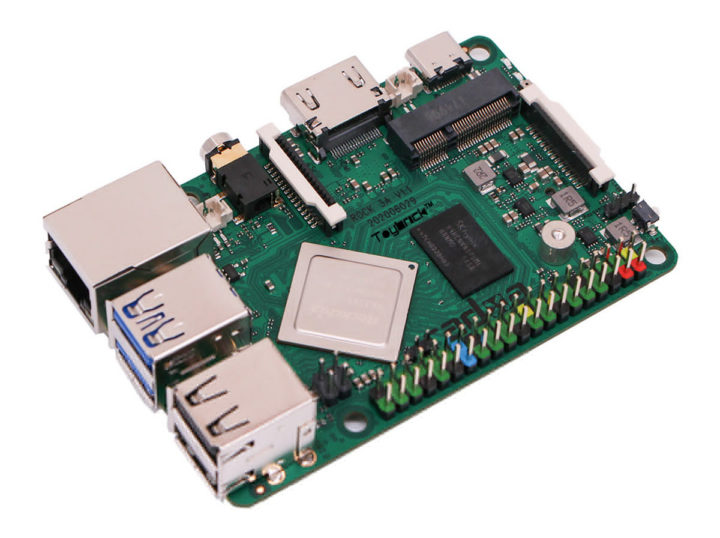
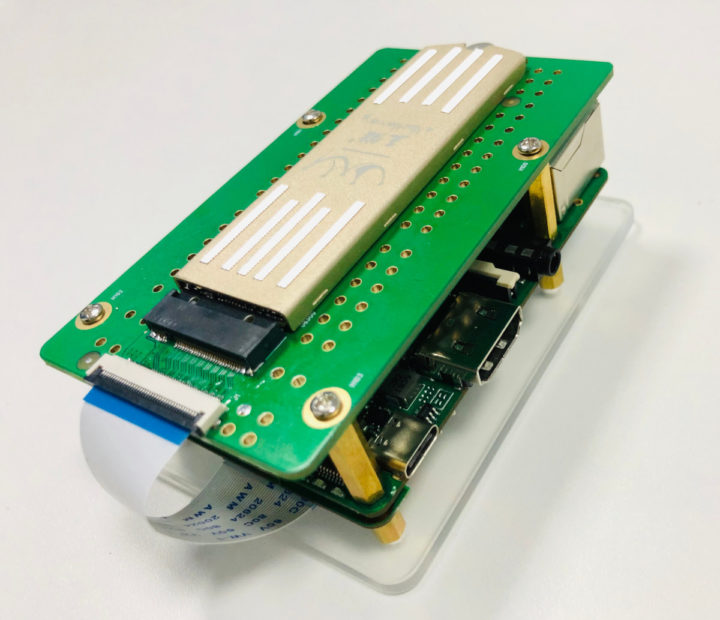


Good try before RK3588.
Not sure about thermal consequences, but people will try to use duct tape instead of screw.
I hope they provide case for RK3588. Something at least like odroid N2/N2+ case. Or something like Intel NUC.
Let’s not put the case before the horse.
RK3588 is vaporware. Pine64 don’t expect it until well into 2022.
Totally. There is no excuse to delay a SoC so much without even clear specifications. They just made a keynote to show what they “could do” in the future giving the impression it was about to be released, but nothing has come up from that, not even the slightest dev board to see something “physical” that you could actually say RK3588 exists and it’s not just a concept.
That SoC would be a life saver for many people, as it would raise the “cheap” boards to a higher level, instead of being permanently stuck with a RK3399, which has old cores and very old fab. 28nm? c’mon, Intel was doing better 10 years ago, and even other competitors like Amlogic started with 12nm fab like 3 or 4 years ago, and for low budget chips, so no excuse, RK3399 was supposed to be a high end the time it was released. Even their RK3566 are made on 22nm, and they’re from 2020. Let’s hope Rockchip focuses a little more on energy saving from now on, when the RK3588 dreamware is released.
AMA here about ROCK 3A.
Are benchmark numbers for SATA3 performance available?
If I connect a USB hard drive to a USB 3.1 port while the port is in SATA mode, will there be any smoke coming out of the board or the harddrive? 🙂
I think no… The voltage level is 1.8V for SATA signal or USB 3 signal. Smoking is because of high voltage most time…
This is around 2V.
Why did you guys break the USB specification? OTG ports aren’t allowed on USB-A. On top of that, USB ports prior to USB-C aren’t allowed to be used for other standards than USB. As such, this board can’t be USB certified or carry the USB logo .
The H96Max I bought a few years ago which was my first RK3399 board does use one of its USB-A ports as OTG for flashing. Not sure what it implies for the certification though.
Lots of companies break the USB specification by doing weird things with USB-A ports, so nothing new. None of those products can be USB certified.
The specific reason in this case, is because USB-A to USB-A isn’t allowed per the USB spec.
Most of the time, the USB A is HOST, device mode maybe never be used by most users. Device mode is for debugging purpose only.
If the logic of USB A to USB A is not allowed is true, we have some trouble with the USB A to USB C, you don’t know which is host, which is device.
I think we will just suggest our users use USB A to C to if they want to use ROCK 3A in device mode, problem solved.
(If you laughed, just upvote, thanks)
Usually it needs changing the dtb to change the role of the ports, I’d expect that to be the same for this board. So if used with the correct dtb it is perfectly in line with the USB requirements and also certifiable IMHO.
How big cooler it require?
Just wondering, is is possible to provide a easy way of bifurcating the pcie gen3x2 to two gen3x1? Looks like a perfect machine to have two wifi card ( wifi4 can go gen2x1, wifi6 with gen3x1 ) and another 2.5G ethernet ( on another gen3x1 ), along with the 1G onboard, this makes a small SOHO wifi router solution
What’s the point of the two Wi-Fi cards? Doesn’t Wi-Fi 6 cover all the bands with backwards compatibility for older devices and have MU-MIMO support? Not saying it’s not useful, I just don’t know about it.
Currently i don’t think( maybe i am really wrong ) there is a m2 card that can run 2.4G and 5G at the same time ( i think it’s called DBDC? ) with good off the shelf software now.Wifi6 : U-Blox JODY-W377, Mediatek MT7915 are all good candidates but software side is still ongoing process. Wifi5 : MT7615 is kind of working?( i got one from asiaRF, waiting for my PIzza cm4 box to come, at least it is running dual band on mt1300 from GL.inet ) maybe 88W8997( i have not dig into this yet ).And since this board is rocking quad core A55@2G, i think having two card with 4×4 Wifi isn’t too overkill.
I guess you’ve not looked at how routers are designed? They always have separate 2.4 and 5GHz radios. Yes, there are solutions that can do concurrent simultaneous dual band, but you’re limited to 1×1, as no such solution has more than two antennas. So if you want to make a router that can offer more than “basic” speeds, you have to use separate Wi-Fi chips for each band.
That said, this SoC wouldn’t be a very good router SoC, as it lacks key features like hardware NAT, packet processor engine and Wi-Fi offloading.
This is close to the upcoming Radxa E25, for network applications:
If the optional wifi 5 can be used in AP mode, this looks like a great network box!!
Is the memory ECC enabled?
How is gigabit ethernet implemented (since you’re using all three 5GHz serdes: 2xUSB3/SATA, 1xPCIe-2.1). Does the chip have other pins for GMII, or RGMII?
Nice work, Tom, I just wish Rockchip made use of RISC-V cores.
Yes, up to two RGMII, not muxed to serdes. SGMII is muxed to serdes but we don’t use it since it only supports up to to phy.
ROCK 3B, we have two native GbEs.
dual nic looks like a good plus for me, can i confirm what signals are provided to the b key? is it possible to provide a M2 B key to M2 E or A or A+E key adapter ( i am still looking forward for a dual Wifi setup )
May missing hardware NAT is a hit, but i think according to Jeff Geerling, dfrobot router board + cm4is more than capable to route gigabit traffic ( with pcie realtek nic ), i think this board should work fine!! By the way, will there be openwrt build for Rock 3A, 3Bs?
Not specifically about the ROCK 3A, but will there be an RK3568 based SOM from Radxa? Parallel RGB and native CAN being huge selling points to me.
Yes, ROCK 3 Compute Module is for you.
Is the DRAM module ECC-capable, and if not, will there be a model with ECC memory?
For the ROCK3 Compute Module, yes, we will provide ECC-capable model for industrial usage. For ROCK 3A, not at the moment. It seems there is no ECC ram chip for LPDDR4 on the market.
Can it PXE boot vanilla Ubuntu? Thinking about adding a small M2 SSD – with boot order PXE then disk – to add some to my homelab orchestrated with Canonical MaaS.
So in the M2 slot on the top of the board, you can also put a NVMe ssd -> For example this one https://www.amazon.de/gp/product/B0866BPJPG/ref=ppx_yo_dt_b_asin_title_o01_s00?ie=UTF8&psc=1
No, you can not, different keying.
Thanks, I’m always confused about these M2 connectors. But now I see the difference on the pictures.
It not only in pics but in description itself: “SSD” one described as M.2 M and “wifi” one – M.2 E
On the other hand, I saw E –> M adapters on Ali, so… we have room for experiments.
Yes, you have room to experiment with a single lane and PCIe 2.0 in this instance…
Great news!
I was thinking about the firefly Station M2, but this one looks better and is cheaper. Shame for the strange M2.M placement.
Is there a IR receiver on board or should it be done through GPIO.
I’ve ordered a Station M2, what I like with it is that it has a heat-spreading enclosure. That makes it a final product compared to an SBC, it’s great. But it’s quite more expensive. I’ll see how it performs once it arrives.
It looks to me like the M2 extension cable will prevent the micro-SD from being used :-/
I think that it could be possible to place a connector under the board that could be used both with an SSD and with a flat cable depending on user preferences: the connector ought to be placed roughly under the USB connectors, with the SSD screw close to the micro-SD connector. If one prefers to use a flat cable with a hat on top, then the cable would still pass at the same place, but will just have to be 8cm longer (or could even be folded and pass on the side).
This type of connector is already used in Rockpi 4 and have all cables so Radxa just replicate layout – nothing new here.
That doesn’t change the fact that it can be improved to support both an SSD or the cable to the hat.
nice! now all we need is are some decent 802.11ax m.2 cards! would love an AP class chipset, a qcn5074 or what not. I tried picking up an pn01 but after a dozen emails no one was had inventory they would part with. this looks like a great board for an AP! if only we had wifi cards!
Too old CPU. No thank you!
RK3568 is new :). It’s fine to think it’s underpowered but too old it is not.
Radxa is making $hit products. Quality has gone down so much. Nothing is in stock. Is Radxa going out of business? Terrible support in their forums. Wouldn’t believe anything they say.
Is it possible to power this board via GPIO at 5V?
In the linuxgizmos.com article that references this one, it states:
“A USB Type-C port appears to power the board at 5V. Radxa notes the availability of QC/PD power support “with a new generation QC/PD protocol IC.” Toybrick will provide a Debian 10 image, and comments at the end of the announcement note RK3568 support in Manjaro Linux and Slackware.”
Although I didn’t see anything about 5V for this board in the Radxa Wiki :/
The 5V they mentioned is for the USB-C port. But it has a wider range from 5V to 20V (via USB PD). I’m not sure about powering it up through the 5V pin on the header. It would be better asked in Radxa forums.
Thank you for your quick reply, Jean-Luc. I didn’t understand how the 5V fit in with that USB-C PD spec because 5V isn’t mentioned on the Radxa Wiki for the Rock 3A…
Took me a while to find it but looks like this is the answer I was hoping for: https://forum.radxa.com/t/supplying-power-through-gpio-5v-or-poe-connector/9400/2
Hi, on my Rock 3a standart USB-C power input stopped working so I tried powering via GPIO and it worked fine. Soldered cables permanently and it runs on 100% cpu without reboots. Than I tried nvme ssd and when I saw write errors I had to remove it. This is because my step-down convertor supports 3A max I think or it could be different reason like weak traces on PCB. What was originally looking like dead board is hopefully saved and it is working fine with USB flash instead of NVME ssd.
It mostly like you are affected by the ROCK 3A production issue. You can contact Radxa for a free dummy 12V USB C power supply. Just send emails to support@radxa.com.
Check: https://forum.radxa.com/t/rock-3a-product-defect-notice-batch-2022-04-22-2022-06-15/11088